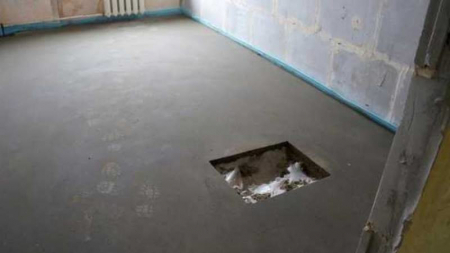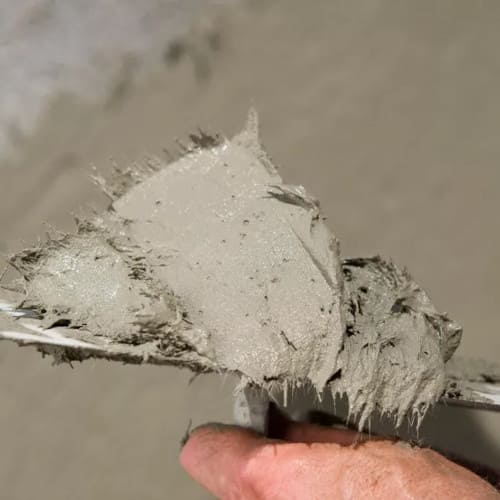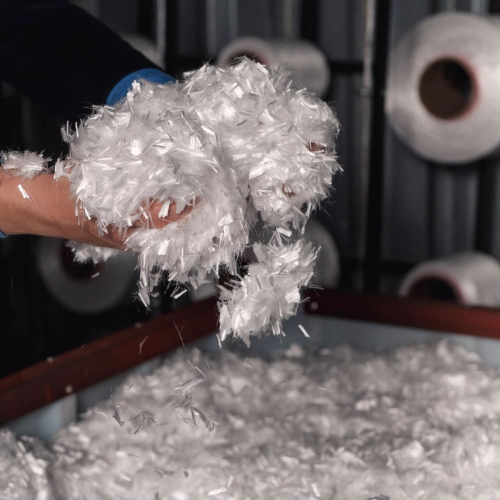
Benefits of screed fiber
The screed is poured over the ceilings when installing floor coverings and installing a floor heating system. The solution is made from concrete, cement-sand, gypsum or multi-component mixture. The complexity of the work lies in the fact that during the drying of the surface shrinkage occurs, microcracks form. Fiber screed improves the quality of the raw material.
Contents
- Is screed fiber justified
- What polymers are added to the concrete solution
- Flooring technology
- The effect of polypropylene fibers on concrete
- Conclusions
The screed is poured over the ceilings when installing floor coverings and installing a floor heating system. The solution is made from concrete, cement-sand, gypsum or multi-component mixture. The complexity of the work lies in the fact that during the drying of the surface shrinkage occurs, microcracks form. Fiber screed improves the quality of the raw material. With the help of a synthetic additive, the tie layer becomes thinner without loss of insulating qualities and strength. In this article, we will figure out what polypropylene gives in the mixture, how many threads are added to the solution, and whether it is possible to do without fiber when installing the floor.

Is screed fiber justified
Certainly, justifies. Polyolefin fibers are randomly distributed throughout the volume of the solution, performing reinforcing functions. Supplement Benefits:
- reduces shrinkage of concrete by 70%;
- 70% less chance of cracking;
- increases resistance to critical tensile and bending loads;
- increases wear resistance;
- reduces mechanical impact.
When the idea to reinforce concrete solutions appeared, finely chopped metal wire was used as a fiber. The approach optimized the work with large areas. The customers were satisfied with the quality of the floors, and the contractors with the speed of installation. However, shortcomings were found in steel reinforcement.
The metal is susceptible to corrosion, is heavy and has sharp edges, which can lead to injury to builders. Thin pieces of metal wire break through the solution hoses and break the agitators. When installing a warm floor, the interaction of steel fibers with electrical elements leads to a short circuit. Therefore, synthetic fiber has spread into a screed, devoid of the above disadvantages.
Polypropylene fibers – it is a hard plastic with a low density that replaces metal reinforcement. Threads of different diameters, lengths and shapes are evenly distributed over the solution, holding the layers together. The fiber fills the voids of the screed, preventing the appearance of microcracks. The fibers are coated with an oily compound to improve adhesion to concrete. Synthetics are much lighter than metal, do not conduct electricity and are not afraid of corrosion. The use of polypropylene extends the life of the equipment for the production of screed mixtures.
What polymers are added to the concrete solution
Synthetic additives are 2-55 mm in length, with a diameter of 20 microns to 700 mm. Polypropylene material is different in color and shape. The type of fiber is selected depending on the task, area and expected load on the concrete surface.

Microfiber
FiberMix monofilament in appearance resembles the finest threads that are added to dry mixes to increase the viscosity of the solution. The purpose of the fiber depends on its length:
- 2, 3, 4 mm are suitable for thickening plasters and finishing mixtures;
- 6 mm is used for a thin layer of self-leveling floor;
- 12 mm is added to the screed of domestic premises, garages, shops;
- 18 mm is used for enterprises and warehouses where there is a high load on the floor.
Fiber fiber consumption per screed depends on the thickness of the layer. For a thin coating, 0.6 kg per 1 cubic meter of solution is sufficient. At constant static and dynamic pressure, 2 kg of 18 mm threads are added to the surface per 1 cube of concrete.

Macrofiber
Fibermix produces two types of macrofibers. ArmoTec polyolefin 14 mm long is used for underfloor heating. The fiber dampens the internal pressure on the concrete from the expansion and contraction of the heating elements, preventing destruction during temperature fluctuations. The proportions of the additive for underfloor heating are higher than those of an ordinary screed: 2 kg per 1 cube of the mixture.
PolyMesh fiber 38 mm long is added to concrete for installation of floor coverings in industrial premises. The coupler maintains big weight, is steady against frosts, blows, the chemical and alkaline environment. PolyMesh fiber increases the flexural strength of the coating. Polypropylene threads relieve pressure on overlaps. For a tangible result, 2-3 kg are mixed into 1 cube of concrete mass.
Flooring technology
Builders practice four ways to level the floor: dry, wet, semi-dry, self-leveling. Polypropylene is added in all cases, however, the semi-dry method is considered the least labor-intensive, and therefore economical and fast. Self-leveling floors by this method are made in one layer.
At the preparatory stage, the surface is thoroughly cleaned of debris and dirt. Then the recesses and cracks of the floor are covered with putty. To improve the properties of the composition, synthetic microfibers are added. The prepared surface is thoroughly washed and dried, after which the beacons are leveled.
Fiber fiber for a semi-dry screed is added to a dry concrete or cement-sand mixture. You can use the whole portion at once, or stir only half, and after adding water, pour in the rest. The solution is thoroughly mixed for uniform reinforcement. The running time of the mixer increases by 15% when adding polypropylene.
To lay a warm floor, a thermal insulation film is placed on the base. For a conventional screed, the solution is poured and evenly distributed with a thickness of 30-50 mm. If the plan requires a second layer or installation of heating elements with subsequent pouring, then they are waiting for the concrete to dry completely.
To polish the floor, it is necessary to use a grinder 20 minutes after the solution has been spread. From drafts and loss of moisture, the finished screed is covered with a film. Solidification of the mixture with fiber occurs in 12 hours. Final work is carried out on the 5th day after installation.
The effect of polypropylene fibers on concrete
In contrast to the standard reinforcing mesh, the fiber is distributed throughout the volume of the solution, increasing the plasticity of the layer. Synthetic additive resists delamination, protects against the formation of voids that lead to cracking. The fibers increase the resistance of the surface to abrasion. Self-leveling floors are not afraid of shocks and other mechanical influences.
The fiber in the CPS reduces the setting time of the solution. With the help of the additive, the heat resistance of the surface is increased. Polypropylene reduces the hygroscopic properties of the cement-sand floor, extending the service life. When synthetic fibers are added, tensile and flexural strength increases.
How does an increase in fiber concentration affect the properties of the solution:
- 0.3 kg – the additive increases the plasticity of the solution, helping to smooth out irregularities;
- 0.6 kg – increases the strength of the screed;
- 0.9 kg – the characteristics of the cement mixture are similar to those of microfiber, the mixture reaches maximum parameters.
The fiber is compatible with any kind of mixtures. Experienced builders recommend adding synthetics in portions, mixing thoroughly. Some people add half of the fibers to the dry ingredients, and the rest is pre-kneaded with water, after which the components are combined.
Conclusions
Polypropylene threads – a reliable replacement for steel reinforcement, devoid of metal flaws. Due to the low weight of synthetic fiber, the material is used on thin ceilings, reducing the overall load on the structure. The flexible structure of the fibers fills the micro-voids of the solution. In case of damage to the floor, the absence of sharp wire will protect against injury.
The only disadvantage of using fiber – This is a purchase of low-quality material. The goods must have certificates confirming the quality. Non-compliance with technological standards leads to the release of unequal fibers without treatment with a composition that improves adhesion, which makes installation difficult. Poor quality plastic begins to release harmful substances over time.
Fibermix manufactures fiber in accordance with international standards. Polyolefin is able to reinforce building mixtures of various composition and thickness. For an effective result, the polymer is selected based on the length of the fibers, the planned load on the floor and the nature of the work.
Recommended products
 |  |
| Microfiber FiberMix | Macrofiber PolyMesh |